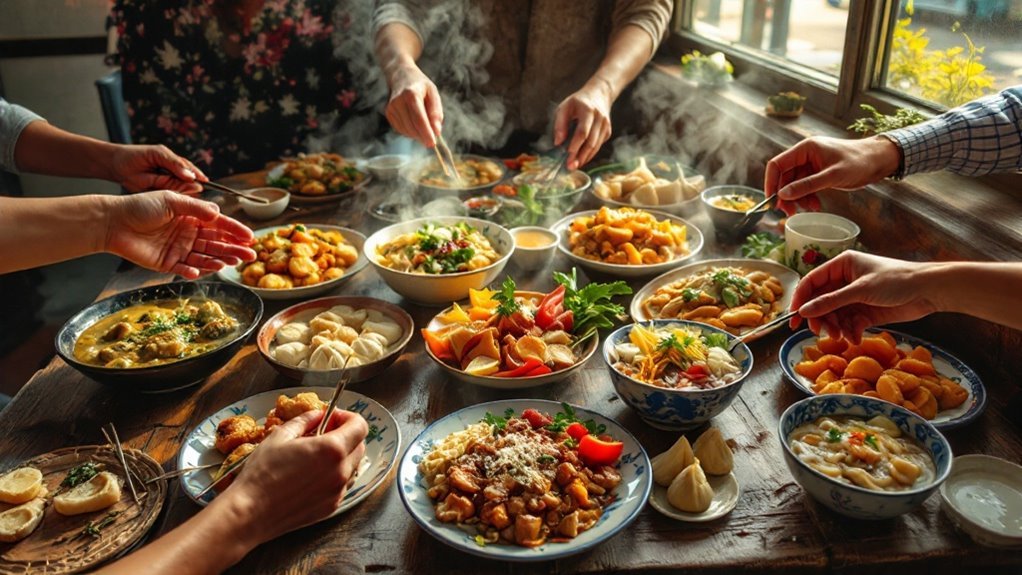Queens offers an unparalleled culinary landscape as New York City’s most diverse food destination. Each neighborhood presents distinctive global flavors, from hand-pulled noodles in Flushing to Greek tavernas in Astoria and South Asian street food in Jackson Heights. Local gems include family-run bakeries, hidden dumpling spots, and authentic regional specialties passed down through generations. The borough’s rich tapestry of cultural cuisine awaits exploration beyond the usual dining spots.
Key Takeaways
- Queens offers authentic cuisine from diverse cultures, including Chinese, South Asian, Greek, Filipino, and Jewish communities across distinct neighborhoods.
- Flushing’s vibrant food scene features hand-pulled noodles, xiao long bao, and Korean specialties like sizzling bibimbap.
- Jackson Heights specializes in South Asian street food, including momos, chaat, and spice-laden curries from local vendors.
- Family-run establishments and hidden gems throughout Queens serve traditional recipes passed down through generations.
- The borough’s culinary landscape ranges from Mediterranean phyllo pastries to Thai boat noodles to Colombian arepas.
Cultural Neighborhoods & Their Signature Dishes
Diversity defines Queens’ culinary landscape, with distinct cultural enclaves offering authentic regional specialties.
In Flushing, Chinese restaurants serve hand-pulled noodles and xiao long bao, while Korean establishments offer sizzling bibimbap and fresh seafood.
Jackson Heights showcases South Asian flavors through street food stalls serving chaat, momos, and traditional curries.
Vibrant street vendors line Jackson Heights’ bustling corners, offering authentic South Asian delicacies from steaming momos to spice-laden curries.
Astoria’s Greek tavernas present fresh Mediterranean fare, including grilled octopus and spanakopita, while its Middle Eastern spots feature shawarma and falafel.
Elmhurst delivers Thai boat noodles and Filipino classics like sisig and kare-kare.
Forest Hills maintains its Jewish culinary heritage with traditional delis serving matzo ball soup and pastrami sandwiches, while Corona’s Latin American eateries specialize in Mexican tacos, Colombian arepas, and Dominican mofongo.
Must-Try Hidden Gems & Local Favorites
Beyond the well-known establishments, Queens harbors countless under-the-radar eateries that locals treasure. From hole-in-the-wall dumpling spots to family-run bakeries passed down through generations, these hidden gems offer authentic flavors without the tourist crowds.
- Astoria’s Mediterranean hideaway, nestled in a basement location, serves hand-stretched phyllo pastries and grilled octopus that rivals Athens’ best tavernas.
- A tiny Filipino turo-turo in Woodside, where steam tables overflow with homestyle classics like kare-kare and crispy lechon, drawing crowds of healthcare workers during lunch.
- Jackson Heights’ Tibetan momo specialist, operating from a modest counter space, crafting perfectly pleated dumplings filled with yak meat and served with fiery house-made chili sauce.
FAQ
Which Months Are Best for Food Festivals in Queens?
Like bees to honey, food festival enthusiasts flock to Queens during the warmer months.
May through September offers the best weather conditions for outdoor food celebrations, with June and July being particularly active.
Notable events include the Queens Night Market from April to October, the Queens Taste in May, and various ethnic food festivals throughout the summer months.
What’s the Average Cost of a Food Tour in Queens?
Food tours in Queens typically range from $50 to $150 per person, depending on duration and neighborhoods visited.
Walking tours through areas like Flushing or Jackson Heights average $65-85 for 3-hour experiences.
Premium tours with transportation and multiple neighborhood stops can reach $125-150.
Self-guided food tours using curated maps or apps cost around $15-30 for digital guides.
Are Reservations Required for Most Popular Ethnic Restaurants in Queens?
Popular ethnic restaurants in Queens vary in their reservation policies.
While some well-known establishments strongly recommend or require reservations, especially during peak dining hours and weekends, many operate on a walk-in basis.
Small family-run eateries typically don’t take reservations at all.
For the most acclaimed restaurants, particularly those featured in food media, calling ahead is advisable to secure a table.
Which Subway Lines Provide Easiest Access to Queens’ Major Food Districts?
With over 20 subway stations serving Queens’ dining hotspots, the borough’s culinary destinations are highly accessible.
The 7 train provides direct access to Flushing’s Asian restaurants, while the N and W lines serve Astoria’s Mediterranean corridor.
The E, F, M, and R trains connect to Jackson Heights’ diverse food scene, and the A train reaches Far Rockaway’s seafood establishments.
Do Most Restaurants in Queens Accept Credit Cards or Prefer Cash?
Most restaurants in Queens accept both credit cards and cash, though payment preferences can vary by establishment.
Smaller family-owned eateries, food carts, and cash-only venues are common, particularly in neighborhoods like Flushing and Jackson Heights.
Many budget-friendly ethnic restaurants prefer cash transactions to avoid processing fees.
It’s advisable to carry some cash when dining in Queens’ diverse food districts.






